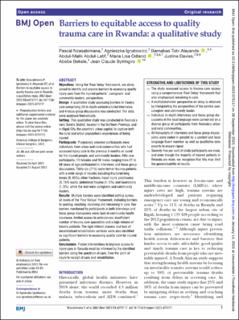| dc.description.abstract | Objectives: Using the ‘Four Delay’ framework, our study aimed to identify and explore barriers to accessing quality injury care from the injured patients’, caregivers’ and community leaders’ perspectives.
Design: A qualitative study assessing barriers to trauma care comprising 20 in-depth semistructured interviews and 4 focus group discussions was conducted. The data were analysed thematically.
Setting: This qualitative study was conducted in Rwanda’s rural Burera District, located in the Northern Province, and in Kigali City, the country’s urban capital, to capture both the rural and urban population’s experiences of being injured.
Participants: Purposively selected participants were individuals from urban and rural communities who had accessed injury care in the previous 6 months or cared for the injured people, and community leaders. Fifty-one participants, 13 females and 38 males ranging from 21 to 68 years of age participated in interviews and focus group discussions. Thirty-six (71%) were former trauma patients with a wide range of injuries including fractured long bones (9, 45%), other fractures, head injury, polytrauma (3, 15% each), abdominal trauma (1, 5%), and lacerations (1, 5%), while the rest were caregivers and community leaders.
Results: Multiple barriers were identified cutting across all levels of the ‘Four Delays’ framework, including barriers to seeking, reaching, receiving and remaining in care. Key barriers mentioned by participants in both interviews and focus group discussions were: lack of community health insurance, limited access to ambulances, insufficient number of trauma care specialists and a high volume of trauma patients. The rigid referral process and lack of decentralised rehabilitation services were also identified as significant barriers to accessing quality care for injured patients.
Conclusions: Future interventions to improve access to injury care in Rwanda must be informed by the identified barriers along the spectrum of care, from the point of injury to receipt of care and rehabilitation. | en_US |

